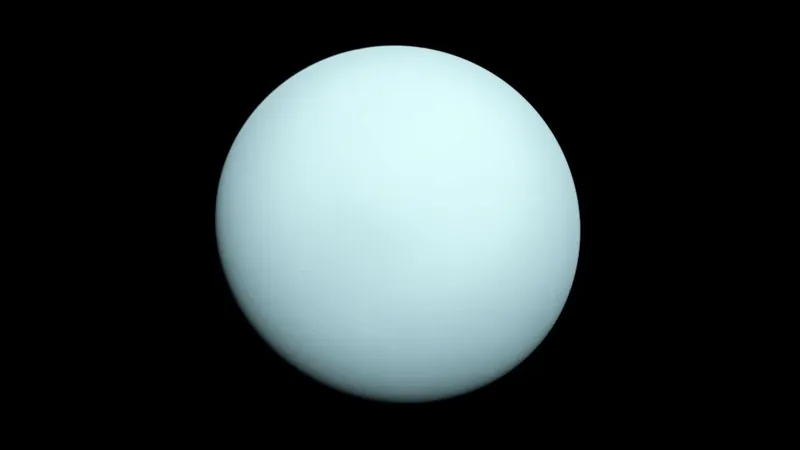
Revelation from Hubble: A Day on Uranus is Actually Longer than We Thought!
2025-04-07
Author: Emily
Fascinating New Discovery
A fascinating new discovery has emerged from the Hubble Space Telescope regarding the length of a day on Uranus, the icy giant of our solar system. A decade of meticulous observations has revealed that Uranus takes approximately 17 hours, 14 minutes, and 52 seconds to complete one full rotation. This new finding is a surprising 28 seconds longer than the previous estimate made by NASA's Voyager 2 spacecraft nearly 40 years ago.
Historical Context
Voyager 2, which made history in January 1986 as the first—and so far only—spacecraft to visit Uranus, initially estimated the planet's rotation period to be 17 hours, 14 minutes, and 24 seconds. This calculation was based on data gathered from radio signals associated with the planet's auroras and direct measurements of its magnetic field, laying the groundwork for mapping Uranus' surface and determining its coordinates.
Inaccuracies and Errors
However, inaccuracies in this early estimate, including inherent uncertainties, resulted in a significant 180-degree error in determining Uranus' longitude. This discrepancy compromised the alignment of its magnetic axis, leading to unreliable coordinate systems that scientists have since struggled to correct.
Hubble's Observational Breakthrough
To address these issues, astronomer Laurent Lamy and his team at the Paris Observatory utilized Hubble's extensive observational data collected from 2011 to 2022. By meticulously tracking the motion of the planet’s auroras over more than a decade, the researchers accurately determined the locations of Uranus' magnetic poles and refined its rotational period estimation.
Significance of the Findings
Lamy emphasized the importance of the continuous data gathered from Hubble, stating, “Without this wealth of data, it would have been impossible to detect the periodic signal with the level of accuracy we achieved.”
Implications for Future Research
This advancement is not merely an academic exercise; it has profound implications for future astronomical studies. The methods developed through this research can now be applied to measure the rotation rates of any celestial body exhibiting a magnetic field and auroras, opening new avenues of exploration for exoplanets and distant worlds.
A New Coordinate System
The revised estimate of Uranus' rotation period now offers a significantly more dependable coordinate system for the planet, expected to maintain accuracy for many years to come—until even more precise measurements can be acquired from future missions.
Planning for Future Missions
The implications are vast: this newly obtained information will assist in planning missions to Uranus, especially in selecting optimal paths for orbital tours and pinpointing suitable sites for atmospheric entry.
Ongoing Mysteries
With these groundbreaking findings, Uranus continues to captivate astronomers and space enthusiasts alike, highlighting the ongoing quest for knowledge about our solar system and beyond. What's next for the mysteries of Uranus? Stay tuned as we anticipate even more discoveries from the cosmos!









 Brasil (PT)
Brasil (PT)
 Canada (EN)
Canada (EN)
 Chile (ES)
Chile (ES)
 Česko (CS)
Česko (CS)
 대한민국 (KO)
대한민국 (KO)
 España (ES)
España (ES)
 France (FR)
France (FR)
 Hong Kong (EN)
Hong Kong (EN)
 Italia (IT)
Italia (IT)
 日本 (JA)
日本 (JA)
 Magyarország (HU)
Magyarország (HU)
 Norge (NO)
Norge (NO)
 Polska (PL)
Polska (PL)
 Schweiz (DE)
Schweiz (DE)
 Singapore (EN)
Singapore (EN)
 Sverige (SV)
Sverige (SV)
 Suomi (FI)
Suomi (FI)
 Türkiye (TR)
Türkiye (TR)
 الإمارات العربية المتحدة (AR)
الإمارات العربية المتحدة (AR)